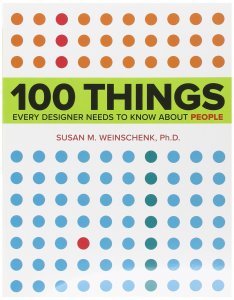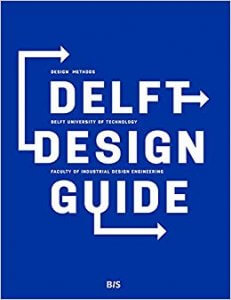From design theory classics to industry guides, we’ve compiled a list of our top eight UX books reading recommendations.
Our top 8 Must-read UX books:
UX book 1: The Design of Everyday Things by Don Norman

The Design of Everyday Things
Don Norman is considered to be one of the founding members of modern UX design. The Design of Everyday Things was first published in 1988, and it’s known as the usability bible.
It’s a must-read for anyone who designs for humans. The book’s main theme explores the relationship between a user and an object’s design.
It highlights that although we’re often keen to blame ourselves when objects appear to malfunction; it’s rarely the fault of the user but rather poor design.
The book claims that: “It could forever change how you experience and interact with your physical surroundings, open your eyes to the perversity of bad design and the desirability of good design, and raise your expectations about how things should be designed.”
Its insights are just as relevant today as they were thirty years ago, making it a UX classic.
UX Book 2: The Inmates Are Running the Asylum: Why High Tech Products Drive Us Crazy and How to Restore the Sanity by Alan Cooper

The Inmates Are Running the Asylum: Why High Tech Products Drive Us Crazy and How to Restore the Sanity
Alan Cooper is a software designer, programmer and founder of Cooper – a leading interaction design consultancy. He’s well known for developing the Goal Directed Design methodology.
The Inmates Are Running the Asylum was first published in 1999. It’s another UX classic that looks at the value of user experience.
The book argues that “the business executives who make the decisions to develop these products are not the ones in control of the technology used to create them.”
It pioneers designing for normal people through the likes of user research and personas. While this might seem like an ageing revelation for some, user research is still often deprioritised in modern UX practice.
UX book 3: The Elements of User Experience: User-Centered Design for the Web by Jesse James Garrett

The Elements of User Experience: User-Centered Design for the Web
Jesse James Garrett is a UX designer who has worked on the web since 1995. Aside from writing The Elements of User Experience, Garrett has developed the Visual Vocabulary, a notation system for documenting UX design; and defining Ajax, an approach to creating web applications.
His book The Elements of User Experience adds more structure to UX design theory classics like The Design of Everyday Things and The Inmates Are Running the Asylum.
It carefully dissects the UX process and looks at how its various stages influence a product.
Here’s what you can expect to read:
“With so many issues involved—usability, brand identity, information architecture, interaction design— creating the user experience can be overwhelmingly complex. This edition cuts through that complexity with clear explanations and vivid illustrations that focus on ideas rather than tools or techniques. Garrett gives readers the big picture of user experience development, from strategy and requirements to information architecture and visual design.”
It’s another foundational UX book that you’ll want to keep close to your desk.
UX book 4: Don’t Make Me Think: A Common Sense Approach to Web Usability by Steve Krug

Don’t Make Me Think: A Common Sense Approach to Web Usability
Don’t Make Me Think by Steve Krug was first published in 2000. It examines how good software is easy to use, and why it shouldn’t make you think.
This is reflected in its writing style. It’s like reading a very well-written, punchy comic book. You’ll instantly understand the points, but it will also make you think deeply about usability and accessibility.
You’ll understand UX – what it’s about and why research is so important. It uses real-world analogies to illustrate how UX can make products and people’s lives so much better.
Krug thinks that people are good at satisficing, taking the first available solution to fix their problem. He thinks design should take advantage of this opportunity.
His publisher says that “anyone involved in creating digital products should read this book.” We agree.
UX book 5: 100 Things Every Designer Needs to Know About People by Susan Weinschenk

100 Things Every Designer Needs to Know About People
100 Things Every Designer Needs to Know About People (and its sequel 100 More Things Every Designer Needs to Know About People) could appeal to those interested in the psychological side of UX.
These straightforward books were written by behavioural psychologist, Dr. Susan Weinschenk, who has worked in the UX field since 1985. She applies neuroscience to understand what motivates people and how to get them to take action. She teaches, speaks, mentors, and consults with Fortune 1000 companies, startups, non-profit agencies, and educational institutions.
Weinschenk uses her expertise to steer designers into making better decisions in both books.
100 Things Every Designer Needs to Know About People can be summarised as:
“This book combines real science and research with practical examples to deliver a guide every designer needs. With it you’ll be able to design more intuitive and engaging work for print, websites, applications, and products that match the way people think, work, and play.”
UX book 6: Interaction Design: Beyond Human-Computer Interaction by Jenny Preece, Helen Sharp & Yvonne Rogers

Interaction Design: Beyond Human-Computer Interaction
Interaction Design is a key academic interaction design resource for students and professionals alike.
Academic contributors include Jenny Preece (Professor and Dean Emerita in the College of Information Studies at the University of Maryland); Helen Sharp (Professor of Software Engineering and Dean in the Faculty of Science, Technology, Engineering and Mathematics at the Open University); and Yvonne Rogers (Professor of Interaction Design and Director of the Interaction Centre at University College London).
This is a comprehensive resource for learning about interaction design, human-computer interaction, information design, web design, while looking at how they relate to AI and data science.
UX book 7: Observing the User Experience: A Practitioner’s Guide to User Research by Elizabeth Goodman, Mike Kuniavsky & Andrea Moed

Observing the User Experience: A Practitioner’s Guide to User Research
Observing the User Experience by Mike Kuniavsky encourages designers to see things from the users’ perspective, offering practical advice for designers.
It aims to bridge the gap between designers and their users, by looking at what users want and need. It offers designers 13 user research techniques to help them create better products.
The book considers real world constraints like tight budgets, scheduling issues, etc, making it a great field guide for designers.
Observing the User Experience is a good introduction to user research, as well as a good refresher.
UX book 8: Delft Design Guide: Design strategies and methods by Annemiek van Boeijen, Jaap Daalhuizen, Roos van der Schoor & Jelle Zijlstra

Delft Design Guide: Design strategies and methods
Delft Design Guide by Annemiek van Boeijen, Jaap Daalhuizen, Jelle Zijlstra, Roos van der Schoor catalogues seventy strategies, techniques and methods taught at TU Delft. Some of these are unique to TU Delft and others are found outside of it.
The main purpose of this book is to teach design students, but it’s a useful resource for practitioners too.
Although this is a dense read, it’s a comprehensive resource that you can revisit again and again.
Now that you have your ultimate list of UX books to start reading why not check out more of our helpful resources for your UX career? Check out our top UX design tools for 2022 and our guide to the best UX portfolio out there.




